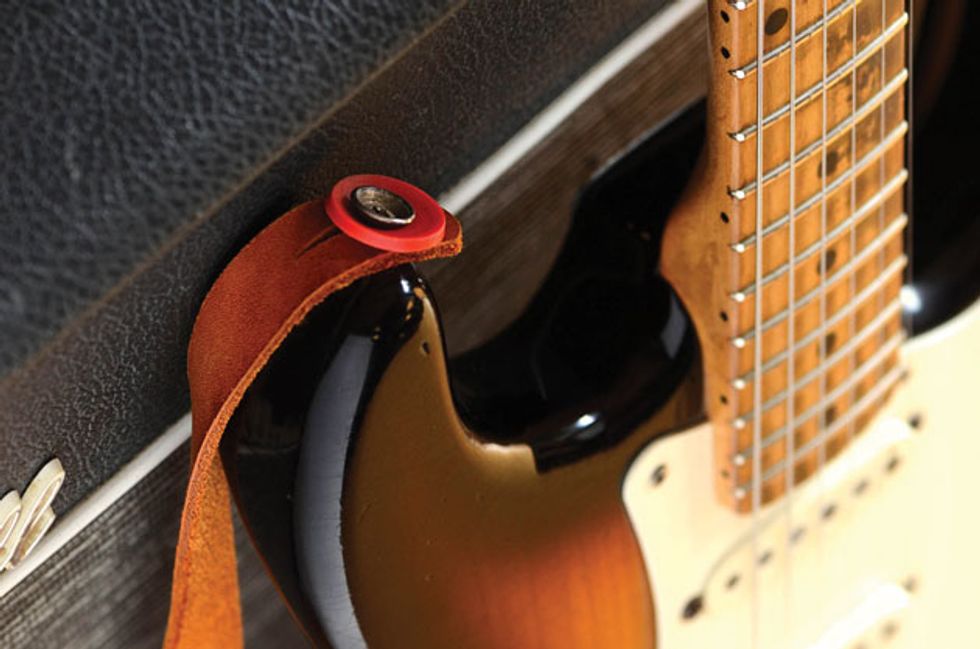Consider the lowly and overlooked strap button for a moment. Most often an afterthought, it doesn’t inspire discussion like sexier accessories and components such as pickups and tuning machines. Even the tone capacitor—hidden inside an instrument’s dark interior compartment—occupies more bandwidth than a strap button.
Yet without this unpretentious appendage, live-rock performances would be a bore. Imagine a seated Pete Townshend delivering the crashing chords of “Baba O’Riley” or Edward Van Halen pounding out a set while perched on a stool. A strapless Jimi Hendrix might have been judged on his music alone. Guitarists would be tethered down and static, like—heaven forbid—keyboardists! Worse yet, vocalists would be free to roam the stage unchallenged.
Mobility is one of the guitar’s strongest suits, so the ability to deliver an accurate performance on the hoof has always made the instrument even more compelling. Early attempts to allow guitarists to stand included tying rope or twine to the instrument, which was fine for cowboys or strolling folk performers. The early guitar straps—which were attached by looping around the body and headstock—weren’t completely without drawbacks, but guitarists took to the idea even with their sketchy balance.
Eventually recognizing the trend, guitar builders began to equip their instruments with a “peg” at the butt end of the body to facilitate attachment there. Performers like Elvis Presley and Johnny Cash even developed a sort of seesaw style that the wide-span straps afforded. At some point, a clever person devised the idea of a strap button for each end of the strap, and we were off to the races. (As an interesting side note, Fender basses were adorned with a button on the back of the headstock until the early 1970s.)
Although button shapes tend to be pretty similar, there have been attempts to innovate. The changes were merely cosmetic at first, with metal and animal parts being the materials of choice. Some makers varied the shape and size to improve the ability to anchor the strap while still allowing for removal of it. Pro guitarists started putting large, flat washers under the buttons to keep straps from falling off. A current and popular derivation of this is the use of the rubber washers from a Grolsch beer bottle (probably because you also get to drink the beer). Van Halen went so far as to devise one of the first “locking” straps by screwing a hardware-store-variety eyebolt into his guitar and fitting his strap with a spring-loaded clip.
Not to be left behind, the aftermarket responded. Both Schaller and Straplok (Dunlop) marketed push-button strap-securing hardware. And this—save for the other various aftermarket safety clips available—is where we’ve been for about three decades.
But what about the strap-button location as a design parameter? Does this ever enter the equation, or is it strictly an add-on once a guitar is designed? With classic guitar shapes penned before the advent of the guitar strap—such as the dreadnought and its second-cousin jazz box—I’d have to guess it was a matter of finding a strong spot that would accept the buttons.
Because the strap’s location relative to your body is somewhat finite, the top button usually determines three things: balance, where the frets are relative to your left hand, and where the bridge is to your right.
For single-cutaway shapes like Gibson’s Les Paul, it seemingly was a matter of mimicking the location found on the larger-bodied hollow guitars, as the LP was essentially a scaled-down version of those instruments. In this case, it was a matter of function following form, and the result allows these guitars to be easily tilted at will. Some players enjoy this adaptability, while others find it useful to move the top button to the back of the body directly behind the neck joint. This changes the attitude of the guitar slightly and provides a different feel.
Alternately, the Stratocaster-style shape thrusts the location of the strap button to the player’s left, effectively moving the balance point to a more neutral position. The net difference between the two is not only balance, but also where the fretboard falls under your hand. The Gibson’s mounting point falls at the 16th fret, while the Strat’s is at the 13th fret—quite a considerable contrast. Interestingly, the Telecaster—which is a shape derived from the traditional dreadnought form—has its top-button location at the 16th fret as well. It’s almost as though the Stratocaster’s top horn was created precisely for the purpose of improved balance.
So, there is plenty to think about when it comes to the importance of those lowly strap buttons and where they are located—certainly when beginning a new design for a guitar. Just remember: It’s a balancing act.











![Rig Rundown: Russian Circles’ Mike Sullivan [2025]](https://www.premierguitar.com/media-library/youtube.jpg?id=62303631&width=1245&height=700&quality=70&coordinates=0%2C0%2C0%2C0)









